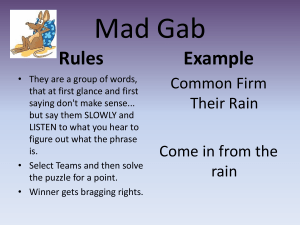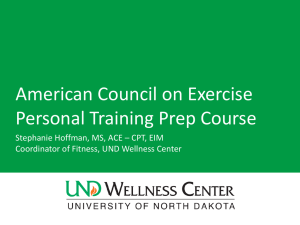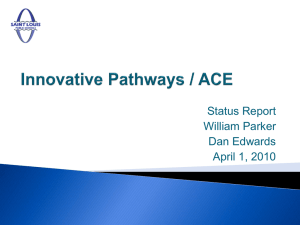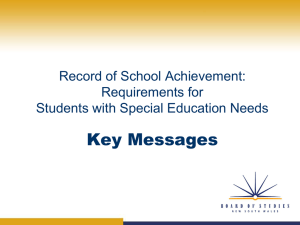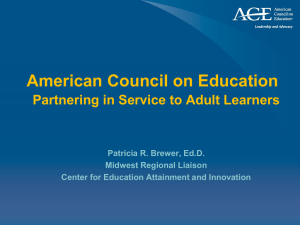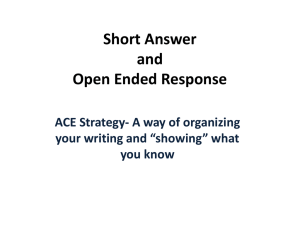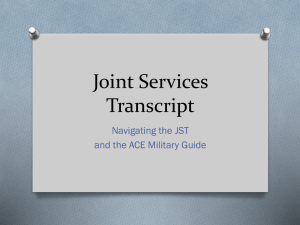ACE - Oklahoma Department of Career and Technology Education
advertisement
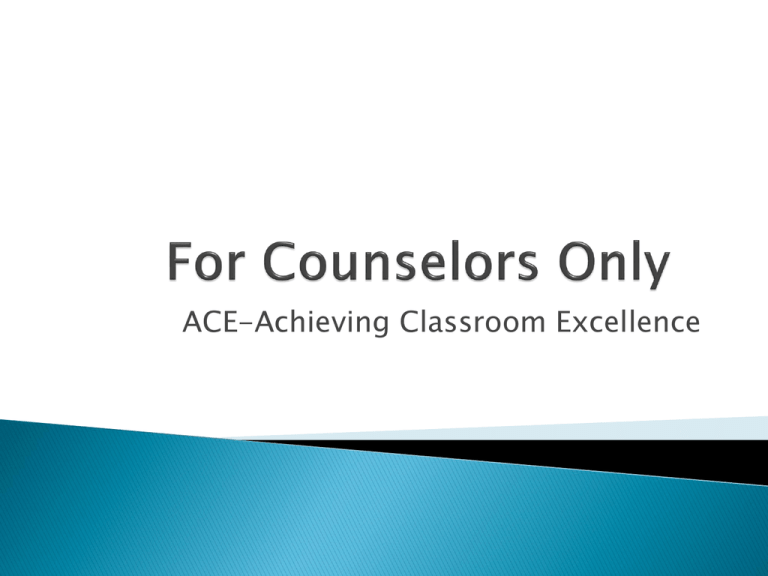
ACE-Achieving Classroom Excellence 2005: Achieving Classroom Excellence Act (SB 982) ◦ Established the ACE Task Force and guiding principles 2006: ACE Amended (SB 1792) ◦ Established the ACE Steering Committee and details 2007: SB 921 ◦ Established the ACE II Task Force 2008: ACE Amended (SB 1769) ◦ Defined funding amounts for remediation 2009: SB 1168 ◦ Established the Legislative ACE Task Force ACE ACE ACE ACE Curriculum Testing Remediation and Intervention Resources College Preparatory/Work Ready Graduation Requirements (Beginning with students who entered the ninth grade in 2006-2007) Parent Opt-Out (Beginning with students who entered the ninth grade in 2006-2007) Three-Unit High School Math Requirement (Beginning with students who entered the ninth grade in 2008-2009) Passport to Financial Literacy (Beginning with students who entered the seventh grade in 2008-2009) Concurrent Enrollment o Truth #1: Beginning with ninth grade students in 2008-2009, three units or sets of competencies in mathematics must be completed in 9th through 12th grade; provided, if a student completes any required courses in Mathematics for high school credit prior to ninth grade, the student may take any other mathematics courses to fulfill the requirement to complete three units in Grades 9 through 12. (ACE Implementation Guide, Page 15) Myth: If a student takes Algebra I or another high school math course in middle school, it does not count. Truth #2: Decisions regarding the transcription of a student’s grade for concurrent college course work, the computation of the student’s grade point average, or how college course work may affect his/her class ranking rest with the local educational authority. (ACE Implementation Guide, Page 16) ◦ Myth: The State Department of Education has rules about which classes must be included in a student’s grade point average (GPA). Demonstrate Mastery of the State Academic Content Standards in the following subject areas: ◦ Algebra I; ◦ English II; and ◦ Two of the following five: Algebra II; Biology I; English III; Geometry; and United States History. Change #1: Appeal Process for students that are denied a standard diploma. (ACE Implementation Guide, Page 26) Change #2: 70 OS 1210.508 states, “Beginning with students who enter the ninth grade in the 2008-09 school year, school districts shall report the highest-achieved state test performance level on the end-of-instruction tests and any business and industry-recognized endorsements attained on the student’s high school transcript. . .. . “ Change #3: The Oklahoma State Board of Education approved confidential End of Course Projects for Algebra I, Algebra II, Geometry, Biology, U.S. History, English II and English III for students to demonstrate mastery in the state content standards for those students who do not score at least at the proficient level on the EOI tests and have either retaken the EOI or taken an alternate test. Updates- Project A, B, and C Guidelines Truth #1: According to state law (70 O.S. § 1210.508), each student who completes the instruction for English II, English III, U.S. History, Biology I, Algebra I, Geometry, and Algebra II at the secondary level shall complete an end-of-instruction test. (ACE Implementation Guide, Page 19) ◦ Myth: If a student has a high enough score on an approved alternate test, they do not have to take the End-of-Instruction test. Truth #1: According to state law (70 O.S. § 1210.508), each student who completes the instruction for English II, English III, United States History, Biology I, Algebra I, Geometry, and Algebra II at the secondary level shall complete an end-of-instruction test. (ACE Implementation Guide, Page 19) ◦ Myth: If a student has a high enough score on an approved alternate test, they do not have to take the End-of-Instruction test. Truth #2: Use of Alternate Test should be recorded on the student’s ACE Demonstration of Mastery Cumulative Record. It may also be placed on the transcript (at the local district’s discretion) but should be distinct from EOI unsatisfactory/limited knowledge/proficient/advanced designation. ◦ Myth: If a student uses an alternate test to meet the ACE Requirement, this should be written on their transcript as if they passed the EOI. Truth #3: According to state law (70 O.S. § 1210.508 and 70 O.S. § 1210.523), students who do not score at least at the proficient level shall be afforded the opportunity to retake each test up to three times each calendar year until at least a proficient score is attained on the tests of Algebra I, English II and two of the other tests required or an approved alternative test. Truth #4: Winter or Trimester, Spring, and Summer are the three options. (ACE Implementation Guide, Page 20) ◦ Myth: Schools only have to offer retakes of the End-of-Instruction tests once per year. Truth #6: Portfolio assessments are available for all end-of-instruction subjects (i.e., Algebra I, Algebra II, Biology I, English II, English III, Geometry, and U.S. History). (ACE Implementation Guide, Page 27) ◦ Myth: There are only portfolio assessments available for four of the End-of-Instruction tests. Truth #7: Some programs offered at Career Tech Centers culminate in a Business and Industry Recognized Endorsement, which must go on the student’s high school transcript. (ACE Implementation Guide, Pages 21 & 111) ◦ Myth #5: Any course a student takes at a Career Tech Center is a Business and Industry Recognized Endorsement that must go on the student’s high school transcript. To demonstrate mastery of reading and mathematics, a student shall attain at least a proficient score on the seventh-grade criterion-referenced tests in reading and mathematics . . . Each student who does not score at least at the proficient level shall be provided remediation for the purpose of assisting the student in performing at least at the proficient level on the eighth-grade criterion-referenced tests in reading and mathematics. (70 O.S. § 1210.522) Students who do not attain at least a proficient score on any end-of-instruction test shall be provided remediation and the opportunity to retake the test until at least a proficient score is attained on the tests of Algebra I, English II, and two of the tests required or an approved alternative test. (70 O.S. § 1210.523) Truth #1: Per student allocations are determined based on the total number of students who qualify for ACE Remediation and the total dollar value appropriated, up to a maximum of $240 for each student who scores Unsatisfactory and $180 for each student who scores Limited Knowledge. (ACE Implementation Guide, Page 33) ◦ Myth: Schools receive $240 for each student who scores Unsatisfactory and $180 for each student who scores Limited Knowledge. Truth #2: According to state law (70 O.S. § 1210.522 and 70 O.S. § 1210.523), beginning with students who entered the ninth grade in 20082009, any student who scores below Proficient on the seventh or eighth grade reading or math test, or any End-of-Instruction test must be provided remediation. (ACE Implementation Guide, Page 31) ◦ Myth: Schools only have to offer remediation if they believe it is necessary or if parents request it. Truth #3: Schools have a lot of flexibility in when and how to offer ACE Remediation; however, schools must follow their district remediation plan approved by their local board of education prior to November 15. (ACE Implementation Guide, Pages 31 & 34) ◦ Myth: Schools can provide remediation however and whenever they choose. Truth #4: Summer remediation is one option available to districts when they are developing their ACE Remediation Plan; however, summer remediation is not required. (ACE Implementation Guide, Page 35) ◦ Myth: Schools must offer remediation in the summer. Truth #5: Schools must provide remediation for seventh and eighth grade reading and math, and any End-of-Instruction test taken beginning with students who entered the ninth grade in 2008-2009 until the student has met the ACE Testing Requirements. (ACE Implementation Guide, Pages 32 & 35) ◦ Myth: Schools only have to provide remediation for reading, math, Algebra I, and English II. Truth #6: Schools must offer remediation to students who qualify, but parents/guardians may opt their children out of remediation. This should be documented in writing with signatures. (ACE Implementation Guide, Page 34) NOTE: In order for a student with an IEP to use a Modified Proficiency Score, the student must have participated in remediation. See approved guidelines for Modified Proficiency Scores for more information. ◦ Myth: Students have to participate in ACE Remediation. Webpage www.sde.ok.gov Resources ACE Implementation Guide MELISSA WHITE EXECUTIVE DIRECTOR OF COUNSELING/ACE OKLAHOMA STATE DEPARTMENT OF EDUCATION MELISSA.WHITE@SDE.OK.GOV (405) 521-3549

